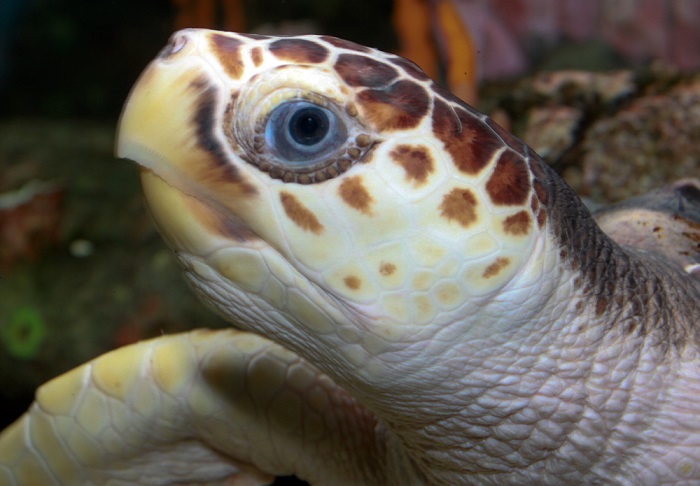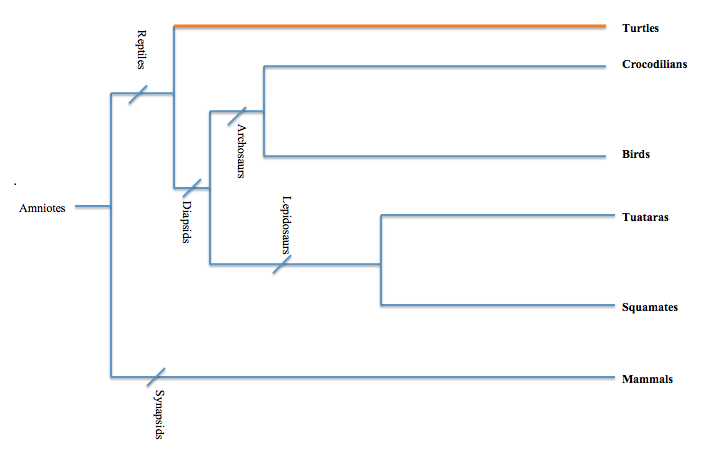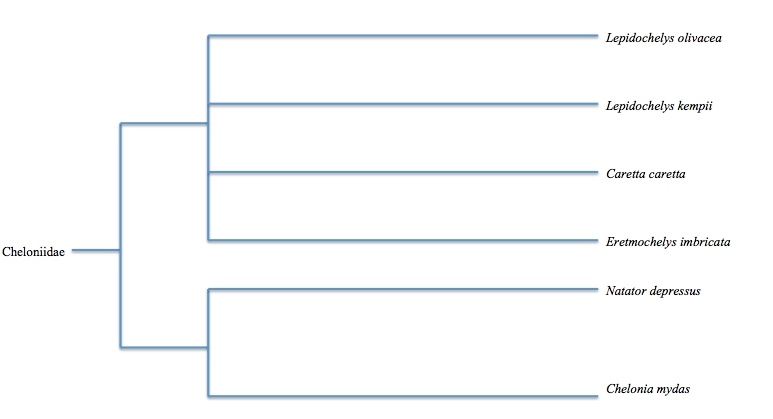Classification

Common name: Loggerhead Sea Turtle
The common name "loggerhead" comes from their massive head (Widecast,
2013).
Scientific name: Caretta caretta
| Domain | Eukayota | Eukaryote: eu-true,karyo-nucleus |
| Kingdom | Animalia | Animal |
| Phylum | Chordata | Vertebrate |
| Class | Reptilia | Reptile |
| Order | Testudines | Turtles and Tortoises |
| Family | Cheloniidae | Sea Turtle |
| Genus | Caretta | Turtle |
| Species | caretta | Turtle |
Domain: Eukarya
The loggerhead sea turtle belongs to the domain Eukarya. The main
characteristic of this domain is that all organisms are eukaryotic,
where eu means true and
karyo means nut or in this case
nucleus (Guill, 1960). Since these cells contain a nucleus, they go
through the cell division of mitosis (Sidwill Friends School, 2006).
Along with all cells containing a nucleus, they also have membrane
bound organelles such as the mitochondria or chloroplasts (Sidwill
Friends School, 2006). The domain Eukarya is highly diverse since it
contains unicellular, colonial and multicellular organisms (Sidwill
Friends School, 2006). In fact three major kingdoms belong to this
domain, the kingdoms Plantae,
Fungi and Animalia (Campbell et al.,
2008).
Kingdom: Animalia
The loggerhead sea turtle belongs to kingdom Animalia (NOAA,
2013). Animalia stems from the Latin
animale, derived from animalis
which means living andanima
meaning soul (Guill, 1960). Kingdoms are distinguished by which way
they acquire nutrients. In the kingdom Animalia, organisms obtain
their food by digesting other organisms, unlike the kingdom Plantae
who produce their own food (Campbell et al., 2008). Loggerhead sea
turtles fit into this kingdom since they are omnivorous. For more
information on their diet click here.
Phylum: Chordata
Loggerhead
sea turtles are classified to the phylum Chordata (NOAA, 2013).
Chordata stems from the Latin root chorda
meaning chord, referring to the characteristic of this phylum, which
is having notochord at some point in their development (Guill, 1960;
Campbell et al., 2008). Another characteristic of organisms in this
phylum is that they are deuterstomes. Deuterstomes stems from the
Greek roots deutero meaning second
and stoma meaning mouth which
refers to the anus forming first and mouth forming second during
development (Campbell et al., 2008; Guill, 1960). Deuterstomes are
also bilaterally symmetrical (Campbell et al., 2008). Loggerhead sea
turtles belong to the subphylum Vertebrata, which stems from the
Latin root vertebra meaning a joint
or backbone (Duermit, 2007; Guill, 1960). Characteristics of the
subphylum vertebrata are that all the organisms have a vertebral
column that is a main skeletal structure along the length of its
body. Other organisms in the subphylum include fish, other reptiles
and mammals (Meyers, 2001). The most closely related phylum to the
Chordates is the phylum Echinodermata (Campbell et al., 2008).

Figure 1. The phylogenetic tree of extant species of amniotes. The
turtle lineage is orange due to the fact that their placement in a
phylogenetic tree is currently unclear. Kelsey Huseth 2013 (Campbell et al., 2008).
Class: Reptilia
Loggerhead
sea turtle are considered to be reptiles along with snakes, lizards,
crocodiles and birds, which places them in the class
Reptilia
(Duermit, 2007; Myers, 2004). Reptilia is derived from the Latin
root word reptilis meaning creeping
(Guill, 1960). Reptiles have an amniotic egg which is an egg
containing four specialized membranes, one being the amnion, that
protects the egg from dessication or other environmental factors
(Campbell et al., 2008; Myers, 2004). Another characteristic of
reptiles are their epidermal scales made up of a certain protein.
Currently, it is not certain as to which position turtles should
take in the phylogenetic tree. However recent evidence shows that
turtles may be more closely related to crocodiles and birds (Myers,
2004).
Order: Testudines
The loggerhead sea turtle belongs to the order Testudines
(NOAA, 2013). Testudine is the order of reptiles that has 260 living species of turtles and tortoises. Turtles and tortoises,
or testudines, are different from other reptiles because they do not have
holes in the side of the skull. The loggerhead's are located above or
below the eyes and are known as temporal fenestrae. There are three
suborders of testudines and they are known as the hidden-necks, the side-necks, and the extinct species
(Sea Turtle Conservancy, 2013; Malory, 2013; Jones
et al., 2012). Hidden-necks are tortoises or turtles that can hide
their head completely in their shells. A side-neck tortoise or
turtle has to bend their head horizontally before
they can put it into their shell (Jones et al., 2012). One can still
see some of their head and neck because they cannot draw in their heads completely.
The loggerhead is a hidden-neck testudine, but they
have lost their ability to draw in their necks (Jones et al., 2012).
Testudines have long lifespans and can live up to over 150 years.
Testudines, turtles and tortoises, can be found living on land or
underwater. The loggerhead can be found on both, but spends most of
its time underwater (Malory, 2013). Testudines use their jaws to
feed on prey instead of teeth. Testudines also have three-chambered hearts.
Testudines are known to be oviparous which means they lay eggs, but
they
do not care for their young after they lay their eggs (Malory,
2013).
Family: Cheloniidae
The loggerhead sea turtle is in the family
Cheloniidae (NOAA,
2013).The sea turtles that would fit into this family are very large
turtles whose front limbs are stronger than their back limbs (Pecor,
2003). Their limbs are flippers that are made for swimming, not for
moving on land.The loggerhead turtle is known to be one of the
largest Cheloniids with a carapace that can range up to 213 cm
(Pecor, 2003). Their carapace is oval
and is covered in bony plates.
The plastron of a Cheloniid is smaller than most turtles and
attaches to the upper shell by ligaments instead of a bony bridge
that many land turtles have. Another characteristic of a Cheloniid
is they cannot pull back their limbs or heads into their shells
(Seaturtles: Cheloniidae-physical characteristics, 2013; Pecor, 2003). The fossil record for Cheloniids
places them among the oldest turtles (Pecor, 2003).

Figure 2. Phylogenetic tree of family Cheloniidae including Caretta
caretta. Kelsey Huseth 2013 (Encyclopedia of Life, 2013).
Genus:
Caretta
The genus is monotypic which means it only contains one species.
Caretta is a Latin version of the French word “caret” which means
turtle, tortoise, or sea turtle (Widecast, 2013; Ananjeva et al., 2006).
Species: caretta
The species name caretta means the same thing as the genus
explained above (caretta comes from the word "caret", meaning turtle, tortoise, or sea turtle)
(Widecast, 2013).
Loggerheads are known for their large heads and thick, horny beak (Save The Turtles, 2013). Their
beak, along with their jaw, allows for the loggerhead to feed on
their prey. To learn more about their pray
click here. The
loggerhead also is the largest hard-shelled turtle with no less than
five pairs of lateral scales on their shell (Save The Turtles,
2013; Ananjeva et al., 2006). Their head contains large
scales (Ananjeva et al., 2006). Another fact about the loggerhead
species is their forelimbs have two claws (Save the Turtles,
2013).The loggerhead species can be found in the Indian, Atlantic,
and Pacific Oceans. Their nesting places are in subtropical along
with temperate locations (Ananjeva et al., 2006).
Links
Habitat and Geography→